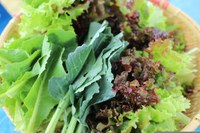Prairie Fare: Enjoy more leafy greens
(Click an image below to view a high-resolution image that can be downloaded)
“What kind of lettuce was that?” my friend asked.
We had some leftover food from taste tests in the refrigerator. She had tried some of the salad.
By the tone of her voice and her wrinkled nose, I could tell she did not like it.
“One of my students made an arugula salad,” I said.
“It was bitter and peppery,” she said bluntly.
I agreed. I was wondering if the salad would be appealing.
“We probably needed to blend the arugula with a milder flavored lettuce,” I said.
“Or leave it out,” she added with a grin.
The recipe did not make it on a publication.
Originally, lettuce was used as a medicinal herb in ancient Roman and Greek times. They were ahead of their time in recognizing the contributions of nutrient-rich plant food to health.
Lettuce is very satisfying to grow in a home garden. After a long winter I am happy to see a green lawn and even happier to place seeds in my hand and plant them in warm soil.
Many types of lettuce will be ready to harvest within a month or two of planting. Check the seed packet for information on planting and estimated harvest time.
We have many varieties of lettuce seeds available as you peruse the seeds in your favorite store. One of my favorites is a “mesclun mix” that includes several types of lettuce. It allows you to make a salad with green and purple leaves with lots of texture and flavor.
Most of the time, this mix also includes our slightly peppery leafy green, arugula, that adds a little zest to salads.
Lettuce varieties include looseleaf, butterhead or Boston, summer crisp or Batavian, Romaine, and iceberg or crisphead. They vary in their shape, color and texture.
When choosing leafy greens, aim for some variety in color or texture. Consider some beet greens, Swiss chard and spinach.
Most of the time, the darker the color, the more nutritious the green. Most of us shortchange ourselves on eating adequate amounts of dark green leafy vegetables and orange-gold vegetables.
Romaine lettuce and kale are darker green in color and are rich sources of carotenoid pigments that our bodies convert to vitamin A. Vitamin A helps maintain healthy eyes and skin.
These dark green leafy vegetables also provide vitamin K, which is an important component in blood clotting.
On average, adults and older children need about 2 to 3 cups of vegetables per day. Two cups of leafy greens is equal to one cup of most other vegetables because leafy greens are kind of “fluffy” (less dense) when measured in a cup.
Take that as an encouragement to eat more leafy greens.
How about iceberg lettuce, the old standby on many buffet lines? It provides crunch and barely any calories. I think of it as a “carrier” for salad dressing, which is not always the most healthful item in your salad.
Unfortunately, iceberg lettuce doesn’t contribute as many nutrients as its darker-green “cousins.” On the positive side, it is usually budget-friendly and lasts a fair amount of time in your refrigerator.
Commercial leafy greens have been linked with many foodborne illness outbreaks, usually due to cross-contamination somewhere in the farm to table continuum. Be sure to clean leafy greens under running cool water. You might need to place the leafy greens in a bowl of cool water and let them soak a couple of minutes, then re-rinse. No one likes gritty salads.
Salad spinners were an excellent invention. If you do not have one, you can remove excess moisture by blotting the lettuce with a paper towel. Bagged produce is considered “ready to eat” and you do not need to re-rinse the salad mixture before serving.
See “From Garden to Table: Leafy Greens” co-written with my colleague Esther McGinnis from NDSU Extension. I shared a very condensed version of some of the highlights from that publication in this column. The publication also includes some “make your own” salad dressing recipes.
Here’s a tasty recipe that goes well with your favorite grilled protein on a warm summer day. This could be a main dish with strips of grilled steak, chicken, salmon or other protein.
Spinach Salad With Poppy Seed Dressing
8 cups bite-sized pieces of fresh spinach
½ cup julienne strips of jicama or carrot sticks
½ cup sliced fresh radishes
1 medium mango or 3 medium fresh oranges, peeled, seeded and cut up
Optional: ½ hard-cooked egg, chopped, on each serving
Optional: strawberries as garnish
If using fresh-from-garden spinach or unbagged spinach from the grocery store, rinse thoroughly and remove excess water. Spinach that is ready-to-eat does not need to be rinsed. Rinse and then prepare other ingredients as noted.
Dressing
2 tablespoons honey
2 tablespoons white vinegar
1 tablespoon yellow mustard
2 tablespoons finely diced onion
2 teaspoons poppy seeds
¼ teaspoon salt
1/3 cup canola oil
In tightly covered container, shake all dressing ingredients. In a large bowl, toss dressing and remaining ingredients. Garnish with egg and/or strawberries if desired.
Makes eight servings. With carrot and ½ egg per serving, each serving has 330 calories, 25 grams (g) fat, 9 g protein, 22 g carbohydrate, 3 g fiber and 320 milligrams sodium.
(Julie Garden-Robinson, Ph.D., R.D., L.R.D., is a North Dakota State University Extension food and nutrition specialist and professor in the Department of Health, Nutrition and Exercise Sciences. Follow her on Twitter @jgardenrobinson)
NDSU Agriculture Communication – June 1, 2023
Source: Julie Garden-Robinson, 701-231-7187, julie.garden-robinson@ndsu.edu
Editor: Elizabeth Cronin, 701-231-7881, elizabeth.cronin@ndsu.edu




